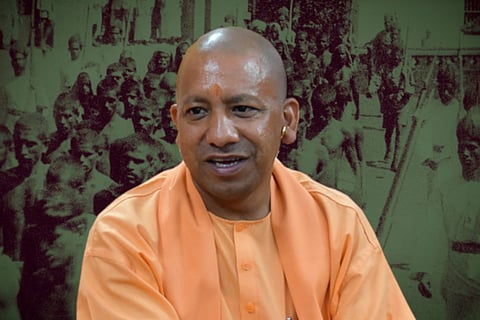

The British called the 1857 uprising in north India 'Sepoy Mutiny'. Decades later, the Hindu Mahasabha's VD Savarkar called it the 'First War of Independence'. The British called the 1921 uprising in Kerala's Malabar region the 'Moplah (Muslim) Revolt'. A century later, Uttar Pradesh Chief Minister Yogi Adityanath calls it 'planned Hindu genocide'. It is not unusual for people to use different terms to denote the same events, based on their different perspectives and different objectives.
The terms that the British employed to denote the two events were based on the perspectives and interests of a colonial power. Savarkar's perspective was that of one wistfully looking forward to the dawn of Freedom. Adityanath's perspective is that of a politician seeking to exploit dubious accounts of a past event for current gains.
The violence in Malabar, back in 1921, was an offshoot of the Khilafat movement launched by conservative Muslims to press the British to reinstate the Sultan of Turkey, whom they had overthrown in World War I, as the Caliph of Islam. There was little public support for the movement in the Islamic world. But Gandhi, who was looking for an issue on which Hindus and Muslims could join hands, thought the Congress could attract Muslims by supporting this movement.
In Malabar, which has a substantial Muslim population, the movement began well, and initially progressed the way Gandhi had envisaged. But, then, things went awry. For a while the British lost control of the region, which was then a part of the sprawling Madras Presidency. Power slid into the hands of fiery Muslim leaders of the Khilafat movement. The British had to employ elite troops to restore their authority. A new police force, styled as the Malabar Special Police, was set up and stationed there for decades. At the height of the uprising, cases of forced conversion to Islam were reported. Many Hindu families fled.
Kerala’s Left movement saw the violent phase as one in which the exploited Muslim peasantry rose against the oppressive upper caste Hindu landlords. Records of the period show that the violent elements did not spare even their co-religionists who had sided with the British at that time. It is not in doubt that the uprising took a communal turn at one point. But dubbing it a 'planned genocide', as Yogi Adityanathh does, is political mischief. Citing no authority whatsoever, he says 10,000 Hindus were estimated to have been massacred. Eminent historian Sumit Sarkar, who studied the event for his book Modern India 1885-1947, puts the number of Hindus killed at about 600 and the number of Hindus converted at about 2,500.
In the retaliatory action by the British, nearly 10,000 Muslim rebels were killed and many more exiled to the Andamans.
Judaism, Christianity and Islam came to India through ports on the Kerala coast where ships from countries to the east and the west of the subcontinent came regularly to trade. The country’s oldest synagogue, church and mosque are all located in the state. The presence of sizable religious minorities in the state is, no doubt, the result of large-scale conversions. However, there is no evidence of large-scale forced conversions. Most of the converts were members of communities subjected to disabilities by the Hindu religious establishment. They saw conversion as a way out of the misery they were born into.
The 1921 violence was an exception to Kerala’s record of communal harmony. If Adityanath takes the trouble to check the facts, he will find that even in the last 100 years, Kerala, including Malabar, witnessed much less communal violence than UP. His use of the term 'jihadis' to refer to the 1921 rebels is an attempt to export the anger generated by recent events elsewhere to Kerala with retrospective effect.
Adityanath, who has to face the electorate early next year, did not stumble upon the Moplah revolt in his search for new campaign ideas. It was resurrected from history by Pranjya Pravah, an RSS think tank, re-ordered to meet the Parivar’s current needs and placed before him and other BJP leaders in the context of the upcoming State Assembly elections. The Pravah also organised an exhibition styled as “100 years of 1921 Malabar Hindu Genocide” at Delhi’s Rajiv Chowk recently.
Adityanath also spoke on the Malabar uprising at a function organised by Panchjanya, a journal from the RSS stable. He called for deep reflection on how to liberate humanity from 'jihadi thought' and ensure that the 'Malabar genocide' is not repeated.
The Parivar campaign built around events of 100 years ago comes in the wake of the BJP’s dismal performance in this year’s Assembly elections in Kerala and inspired media reports that the state will be the next terrorist hub after Afghanistan.
The ISIS is known to have recruited 100 young Keralites, including six non-Muslims, till 2019. Chief Minister Pinarayi Vijayan said recently that 72 of them were working abroad when they were recruited, and one of them was a Hindu. The remaining 27 included five recent converts to Islam.
According to media reports, the Union government has instructed airports to send the ISIS recruits back if they try to return. It is not clear why the government is unwilling to let them in and prosecute them under whatever law that is applicable.
BRP Bhaskar is a senior human rights activist and veteran journalist. He had served as the editor in most of the leading newspapers in India like The Hindu, The Statesman, Deccan Herald.
Image in the background is from Wikimedia Commons